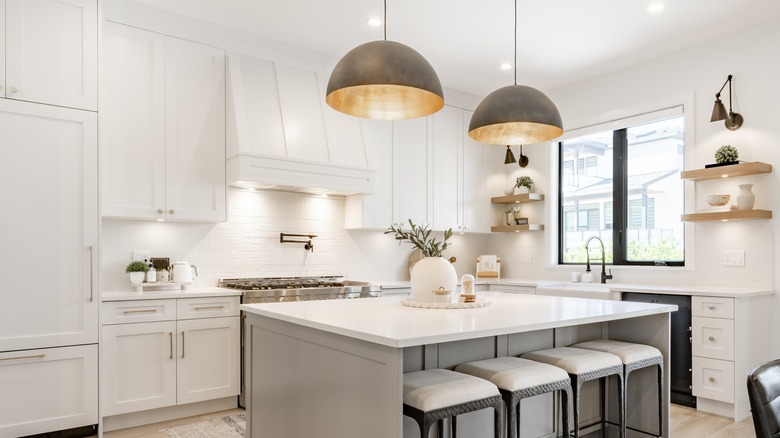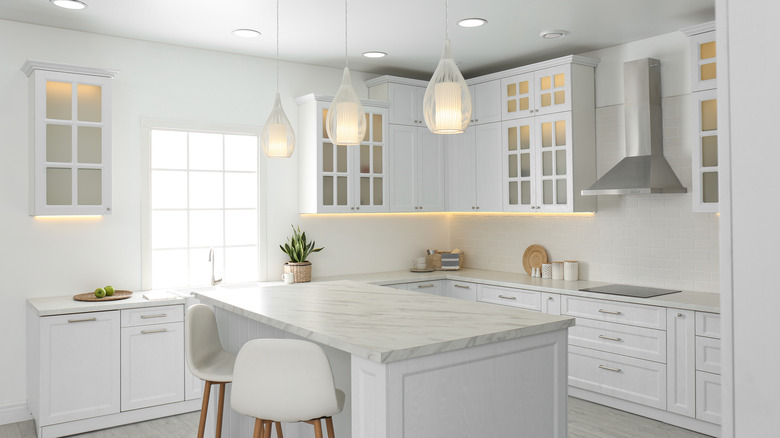The Modern Kitchen Trend HGTV's Jasmine Roth Is Absolutely Loving
If there's one thing Jasmine Roth is great at, it's elevating a space with innovative custom design. On HGTV's "Hidden Potential," Roth used her expertise to craft custom homes that were anything but cookie-cutter. Now, Jasmine Roth does the same for DIY enthusiasts who are in over their heads in "Help! I Wrecked My House!" Luckily, she shares many of her design tips on her blog, so you don't need a spot on her show if you're looking to develop your personal interior style.
Roth knows the pivotal role that lighting plays in setting the tone for a space. Especially in the kitchen, the wrong lighting can make the room feel more like an austere and sterile laboratory than a welcoming enclave for sharing meals and memories. One trend Roth adores for creating homely warmth in the kitchen is the use of modern pendant lighting. While fluorescent and recessed lights without dimmers can create a harsh, cold look, pendant shades are a stylish way to create an alluring ambiance. Jasmine Roth frequently incorporates this lighting style into projects showcased on her television series and social media. In the Jasmine Roth x Hunter collection, she curates an assortment of pendant shades for purchase, reflecting her admiration for the trend. Here's why the designer is such a big fan of pendant lights.
Selecting the perfect pendants
For Roth, Adding stylish pendant lighting shades to your kitchen is a simple way to revitalize the room and infuse it with modern touches. Generally more modern, cost-effective, energy-efficient, and easier to install than a chandelier, pendant lighting also creates focused lighting exactly where you need it, such as over an island or peninsula. This is an elegant and understated way to draw attention to the most noteworthy elements of your kitchen. Shades come in many variations, but Jasmine Roth's penchant is a retro-modern pendant. In season 3, episode 5 of "Help! I Wrecked My House!" the designer's use of three sleek black and white pendant shades is the ideal touch for her client's bright, bold, contemporary kitchen.
"Pendant lights are an elevated way to brighten any room and carry the bonus of emphasizing your ceiling height," Roth shares via her blog. As such, these drop-down fixtures are preferable for larger kitchens with higher ceilings. If your kitchen is too small, the style can appear cluttered or imposing. For darker kitchens, pendant lights may need to be accompanied by other lighting, such as dimmable recessed or under-cabinet lights. If you're ready to replace your light fixtures, it's important to consider a few factors to ensure you choose the perfect pendant shades and install them effectively for your space.
Select a show-stopping shade
When it comes to your kitchen, it's all about blending function and style. There's much to consider before installing pendant lighting. You'll want to start by mapping out how much lighting is needed and where. If your kitchen receives good natural lighting, you may want to opt for a few smaller pendants to create warmth and draw attention to a kitchen island. If your home is open-layout, it may be the perfect opportunity to go for multiple pendants or one large statement piece.
The general rule is that there should be between 12 to 20 inches between your ceiling and the pendant or at least 7 feet between the bottom of your pendant and the floor. It's also important to leave enough space between multiple pendants so that the light is well-distributed. 30 inches of space between pendants is recommended. But, depending on the size of your space, the height of your ceilings, and the type of fixtures selected, you may need to tweak these guidelines to create the right ambiance.
Before you go shopping, you'll want to consider what materials and designs fit your decor best. Industrial-inspired smoked glass, modern metals, or neutral bohemian materials, your selection will set the style of your kitchen. Finally, when you're ready to install, you can consider hacks for hanging pendant lights. But, when working with electricity or delicate fixtures, it's always wise to get help from a trained professional.


